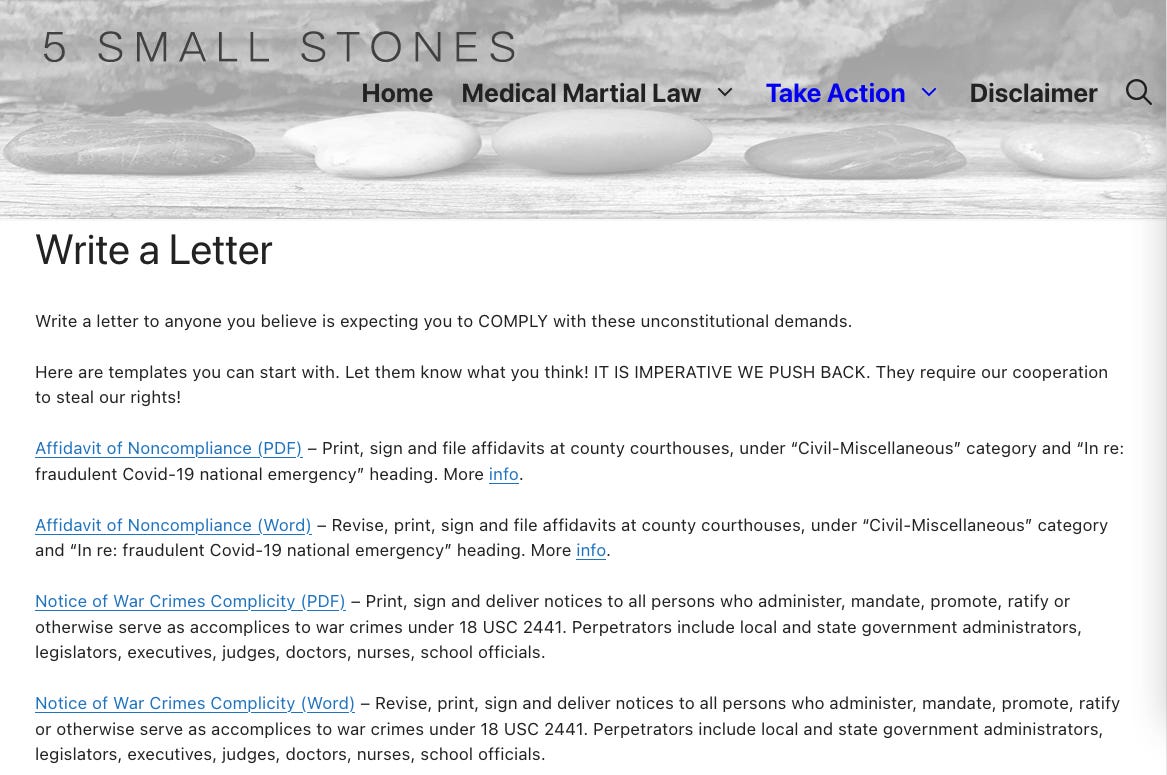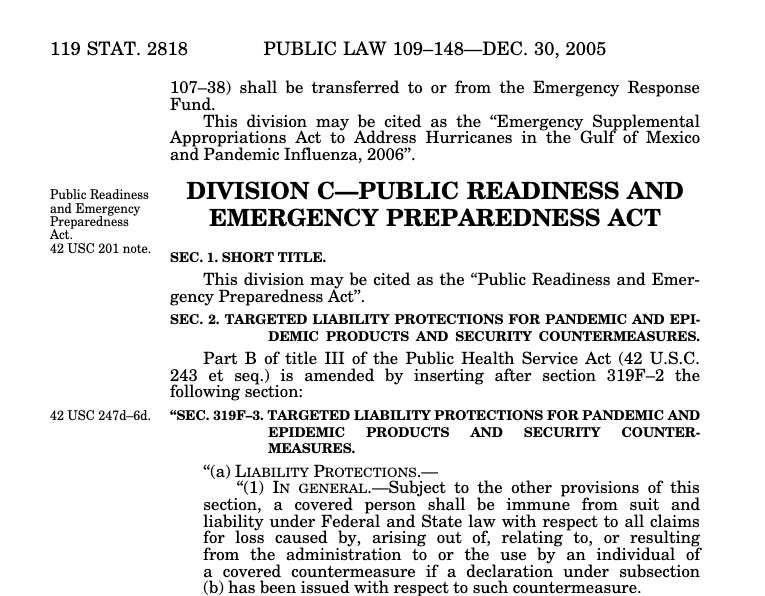Five Small Stones 'Write a Letter' Page
Also a research primer on federal law numbering systems.
For readers looking for the two simplest legal documents, the main site to bookmark is the Five Small Stones Write a Letter page.
The two documents currently available there — Affidavit of Noncompliance and Notice of War Crimes Complicity — are aimed at 1) demonstrating the breadth and depth of public understanding and outrage through court records and 2) emboldening judges, prosecutors, sheriffs, police officers, legislators, administrators, doctors, hospital executives, pharmacists, nurses, and all other low- to mid-level murderers and accomplices, to switch sides.
The basic message of the Affidavit of Noncompliance is:
I understand that millions of war crimes are being committed every day by thousands of people in America and around the world.
I’m naming, condemning and refusing to participate in those crimes.
I support restoration of the US Constitution, and prosecution of the perpetrators in criminal and civil courts.
The basic message of the Notice of War Crimes Complicity is:
Your past and present actions meet the legal definitions of war crimes. Stop now.
Note about version control
As the letters and more complex legal templates are revised and improved in the coming weeks, keeping track of links and cross-links is going to get more difficult.
For example, I updated the Affidavit of Noncompliance after going to my county courthouse to file it with our court clerk, and learning that an appropriate title for the case is “In re: fraudulent Covid-19 national emergency” and that the category for the case is “Civil-Miscellaneous."
I updated the Notice of War Crimes Complicity in response to a reader who requested that the crime citation to 18 USC 2441 be included.
We’ll try to make sure the links work properly as the updates happen. But if you have trouble finding something you want to download and use, please contact me so I can help you track down live links.
Research Primer on U.S. Federal Law Numbering
Last week there was some discussion in the comments, trying to untangle the many different numbering systems used to refer to American federal laws.
Wikipedia’s entry on Statutes at Large is pretty okay, and there’s an archived 2010 page from the General Printing Office about the difference between public laws and private laws, which is kind of interesting.
For readers interested in learning more about the recording system for US laws, with a view to doing some digging of your own, below is an overview.
Fair warning: it’s boring.
The overview tracks — as an example — the documented process through which Congress gave civil liability exemptions to the manufacturers and murderers who have produced and used the FDA-authorized bioweapons known as Covid-19 vaccines.
The ‘targeted liability protections’ were authorized by Congress through the PREP Act in 2005 and subsequent additional revisions to the 1938 Food Drug and Cosmetics Act and the 1944 Public Health Service Act.
The two major laws under which most of this mess falls are the 1938 Food Drug and Cosmetics Act (FDCA), located at Title 21 US Code, Chapter 9, starting at Section 301 and the 1944 Public Health Service Act (PHSA), located at Title 42, US Code, Chapter 6A, starting at Section 201.
The FDCA was allegedly passed to protect the purity and safety of foods and drugs.
The PHSA was allegedly passed to protect public health from communicable diseases, through programs including ‘vaccination.'
Lies, as it turns out.
The unconstitutional and illegitimate legislative amendments to and expansion of federal executive power under those two laws — and the merger of the Department of Defense Chemical and Biological Warfare program with the Health and Human Services public health emergency program — form strands of the story told in the timeline at American Domestic Bioterrorism Program.
For starters, there are four major numbering systems, and they correspond to the multi-step law-making process of:
Introduction + committee review + debate in Congress of a proposed new law
Voting + passage by Congress + signing by President
Entry into the Congressional record
Codification into the existing US Code
1. House and Senate Resolutions
House Resolution/HR 2863, “Department of Defense, Emergency Supplemental Appropriations to Address Hurricanes in the Gulf of Mexico, and Pandemic Influenza Act of 2006,” included the “Public Readiness and Emergency Preparedness (PREP) Act” at the last section, under the heading ‘Division C.’
HR 2863 was introduced on June 10, 2005 by Florida’s 10th District Congressman C.W. Bill Young.
2. Public Law Citation
After a few months of committee meetings, the House passed a final version on Dec. 19, 2005. 308-106, two voted ‘present,’ 18 not voting.
The Senate passed the same law on Dec. 21, 2005. 93-0, seven not voting.
President George W. Bush signed it into law as Public Law/Pub. L./ PL 109-148, on Dec. 30, 2005.
The “109” refers to the 109th Congress, which sat from Jan. 3, 2005 to Jan. 3, 2007.
The “148” refers to where, in the chronological sequence of all 482 public laws passed by the 109th Congress during its two years of activity, the DOD Emergency Supplemental act including the PREP Act piece, was passed.
3. US Code Citation
From there, the various provisions of the new law were inserted into the relevant sections of the Code of Laws of the United States of America, or US Code.
The US Code includes 53 Titles, from Title 1 - General Provisions, through Title 18 - Crimes and Criminal Procedure and Title 21 - Food and Drugs to Title 42 - Public Health and Welfare.
It ends at Title 54 - National Park Service and Related Programs. There’s a placeholder for small business regulation at Title 53.
The PREP Act provision through which Congress exempted DOD/HHS-authorized war criminals from civil liability for committing war crimes entered the US Code at 42 USC 247d-6d.
Section 247d-6d - Targeted liability protections for pandemic and epidemic products and security countermeasures
4. Statutes at Large Citation
After the Public Law is passed, and the text sections are inserted into the overall US Code at the relevant places, another copy of the text goes into the official record of Acts of Congress.
This Congressional record is called the Statutes at Large and abbreviated ‘Stat.’ in citations.
The Department of Defense, Emergency Supplemental Appropriations to Address Hurricanes in the Gulf of Mexico, and Pandemic Influenza Act of 2006, starts at 119 Stat. 2680.
119 refers to the volume. 2680 refers to the page number. The numbers are printed in the top left or top right corner of every page.
The whole DOD supplemental appropriations act is 154 pages, and ends at 119 Stat. 2832.
The PREP Act, at Division C of the DOD supplemental appropriations act, is only 14 pages, and runs from 119 Stat. 2818 to 119 Stat. 2832.
Titles, Chapters, Subchapters, Parts, Sections…
Hierarchical, document-navigation terms like “titles” and “sections” are used in both the Public Law (Pub. L. or PL) — the version of the law that Congress passes during its sessions and Presidents sign — and also in the US Code: the totality of existing US federal laws into which each new provision gets incorporated.
BUT.
The titles, sections and other numbers are not the same between those two records.
For a general example, Title X of a Public Law just means it’s the tenth major part that Congress considered in that bill. And the topics in a bill can include lots of things that are unrelated to each other and got mashed in together to get them passed without people really knowing what’s in the bill they’re voting on.
The corresponding location of the new law in the US Code, is printed in the margin of the Public Law record.
The ‘targeted liability protections’ provision in the DOD emergency supplemental appropriations act at Division C, which is the PREP Act, simply refers to the third division of that overall DOD appropriations bill. The rest of the bill is about hurricanes and DOD funding.
Under Division C, Section 1 gave the title of the act — Public Readiness and Emergency Preparedness.
Section 2 of Division C added Section 319F-3 to Title III, Part B of Title 42 (the original 1944 Public Health Service Act) and named that section “targeted liability protections for pandemic and epidemic products and security countermeasures.”
The text reads:
Part B of title III of the Public Health Service Act (42 U.S.C. 243 et seq.) is amended by inserting after section 319F–2 the following section: ‘SEC. 319F–3. TARGETED LIABILITY PROTECTIONS FOR PANDEMIC AND EPIDEMIC PRODUCTS AND SECURITY COUNTER-MEASURES.
And over in the left margin, the margin note “42 USC 247d-6d” appears, to let the reader know that the law now forms part of Title 42, Public Health and Welfare, Chapter 6A - Public Health Service, Subchapter 2 - General Powers and Duties, Part B - Federal-State Cooperation, Section 247d-6d: Targeted liability protections for pandemic and epidemic products and security countermeasures.
Conclusion & Miscellaneous Other Points
In summary, Congressionally-authorized civil law impunity for war criminals
=
‘targeted liability protections for pandemic and epidemic products and security countermeasures’
=
42 USC 247d-6d
=
PREP Act of 2005
=
Department of Defense, Emergency Supplemental Appropriations to Address Hurricanes in the Gulf of Mexico, and Pandemic Influenza Act of 2006, Division C
=
Public Health Service Act, Section 319F-3
Subsequent revisions
If you go to 42 USC 247d-6d at the Cornell database and scroll to the bottom of the page, you can read about the dates and Public Laws through which the “targeted liability protections” section was added and then revised more — to allow DOD to kill off more people, more quickly and quietly, and to better protect the DOD-directed killers from civil liability, as follows:
July 1, 1944 - Original Public Health Service Act. Chapter 373, Title III,
Dec. 30, 2005 - PREP Act/targeted liability protections. § 319F–3 of PHSA. Pub. L. 109–148, at Division C, Section 2. 119 Stat. 2818.
Mar. 13, 2013 - Targeted liability protections amended, Pub. L. 113–5, [Pandemic and All-Hazards Preparedness Reauthorization Act], at Title IV, Section 402(g)(2), (3). 127 Stat. 196.
Mar. 18, 2020 - Targeted liability protections amended, Pub. L. 116–127, [Families First Coronavirus Response Act] at Division F, Section 6005. 134 Stat. 207
Mar. 27, 2020 - Targeted liability protections amended Pub. L. 116–136, [Coronavirus Aid, Relief, and Economic Security (CARES) Act] at Division A, Title III Section 3103. 134 Stat. 361
Sunset clauses
Some Congressional acts include sunset clauses: a date after which the law will no longer be in force.
Sometimes Congress quietly extends them.
Sometimes provisions actually do expire.
Sometimes they expire under one set of laws, only to be replaced in another set of laws.
The only way to track the developments is to dig around in the legal messes they leave in their wake, using the tracking tools described here.
And also
What Congress has passed, Congress can repeal and federal courts can find unconstitutional, null and void.







Katherine, you are something! (BTW, thank you so much for your very thorough reply to my query related to this topic. My bad for failing to thank and acknowledge you for taking the time to provide such a thorough answer to my question about all of this unlawful gobbledygook.)
Aside from all of this appearing to me to be completely unconstitutional, PREP does have its provision related to willful misconduct. If any part of any of the crap carried out in the name of PREP can be shown to qualify as willful misconduct, all of the protections are out the window, yes?
Thanks for wading through this Katherine. I think I speak for many of your readers when I say we really appreciate the time and effort you put into clarifying this mess. Like you pointed out, I got bored with my earlier efforts because it took so much time just to wade through everything to try and make sense of it all.